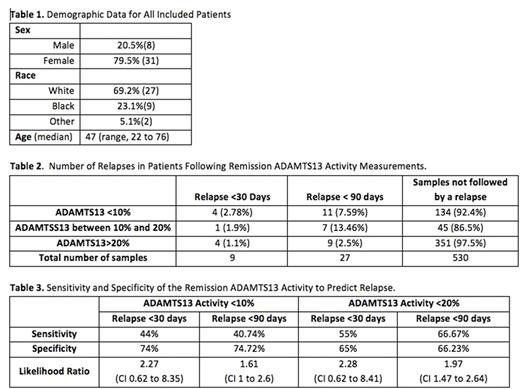Abstract
Background: Acquired, immune-mediated thrombotic thrombocytopenic purpura (iTTP) is defined by thrombocytopenia and microangiopathic hemolytic anemia due to ADAMTS13 deficiency. After the first episode of TTP, about 30-40% of the patients will experience one or more relapse. It has been hypothesized that relapses of iTTP may be associated with severely deficient ADAMTS13 activity during remission. However, some patients with iTTP will remain on remission despite persisting severely decreased ADAMTS13 activity. Moreover, spontaneous recovery of ADAMTS13 activity has also been reported. Whether severe ADAMTS13 deficiency during remission increases risk for relapse is not certain. Therefore we have evaluated the ability of ADAMTS13 activity levels measured during clinical remission to predict relapses of iTTP.
Methods: Between March 2004 and June 2017, we collected clinical data and plasma samples from patients who presented to The Ohio State University with clinical diagnosis of iTTP (defined as thrombocytopenia, microangiopathic hemolytic anemia, without an alternative explanation). The diagnosis was confirmed by severely deficient ADAMTS13 activity (<10%). All ADAMTS13 measurements in this cohort were obtained from patients in remission with a platelet count >150 x109/uL and no clinical signs of active TTP. ADAMTS13 activity was determined using a SELDI-TOF mass-spectrometer-based method. For the present study, we only included samples obtained from patients that had never received any prophylactic treatment including rituximab or cyclosporine. To determine the ability of ADAMTS13 activity to predict a relapse in the following 30 and 90 days, we calculated the sensitivity, specificity and likelihood ratio of the test when the ADAMTS13 activity was less than 10% and less than 20%.
Results: A total of 557 ADAMTS13 activity measurements were drawn in 39 patients while in remission, with a median interval of 91 days between samples. The demographic characteristics of the population are shown in Table 1. Fourteen patients had no history of relapses and 25 patients had at least one prior relapse. There were 23 relapses in 13 patients during the study period. Of the 557 samples, 145 (26%) were read as less than 10%, 52 (9.4%) were between 10% and 20%, and 360 (64.6%) were >20%. Only 4 (2.78%) and 11(7.59%) of the samples with ADAMTS13 activity <10%, were followed by a relapse in the next 30 and 90 days, respectively. The details of the ADAMTS13 activity during remission are listed in Table 2. The median number of samples from each patient was 10 (range 2 to 41). The sensitivity, specificity and likelihood ratio for relapse for ADAMTS13 activity <10% and 20%, over the following 30 and 90 days are shown in Table 3.
Conclusions:
- There is a high variability on the ADAMTS13 activity during remission from iTTP, with 25% of the samples showing severe deficiency (<10%) and 35% with activity less than 20%.
- With only a small portion of severely deficient samples leading to relapses, both for the 30 and 90-day period, an ADAMTS13 activity of <10% measured during remission does not uniformly lead to relapse.
- An ADAMTS13 activity < 20% is a better marker for relapse prediction than < 10%.
- These findings call for prospective, randomized studies to evaluate the best biomarker or combination of biomarkers to predict a relapse.
No relevant conflicts of interest to declare.
Author notes
Asterisk with author names denotes non-ASH members.


This feature is available to Subscribers Only
Sign In or Create an Account Close Modal